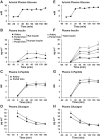Comparison of the physiological relevance of systemic vs. portal insulin delivery to evaluate whole body glucose flux during an insulin clamp
- PMID: 25516552
- PMCID: PMC4312835
- DOI: 10.1152/ajpendo.00406.2014
Comparison of the physiological relevance of systemic vs. portal insulin delivery to evaluate whole body glucose flux during an insulin clamp
Abstract
To understand the underlying pathology of metabolic diseases, such as diabetes, an accurate determination of whole body glucose flux needs to be made by a method that maintains key physiological features. One such feature is a positive differential in insulin concentration between the portal venous and systemic arterial circulation (P/S-IG). P/S-IG during the determination of the relative contribution of liver and extra-liver tissues/organs to whole body glucose flux during an insulin clamp with either systemic (SID) or portal (PID) insulin delivery was examined with insulin infusion rates of 1, 2, and 5 mU·kg(-1)·min(-1) under either euglycemic or hyperglycemic conditions in 6-h-fasted conscious normal rats. A P/S-IG was initially determined with endogenous insulin secretion to exist with a value of 2.07. During an insulin clamp, while inhibiting endogenous insulin secretion by somatostatin, P/S-IG remained at 2.2 with PID, whereas, P/S-IG disappeared completely with SID, which exhibited higher arterial and lower portal insulin levels compared with PID. Consequently, glucose disappearance rates and muscle glycogen synthetic rates were higher, but suppression of endogenous glucose production and liver glycogen synthetic rates were lower with SID compared with PID. When the insulin clamp was performed with SID at 2 and 5 mU·kg(-1)·min(-1) without managing endogenous insulin secretion under euglycemic but not hyperglycemic conditions, endogenous insulin secretion was completely suppressed with SID, and the P/S-IG disappeared. Thus, compared with PID, an insulin clamp with SID underestimates the contribution of liver in response to insulin to whole body glucose flux.
Keywords: insulin clamp method; liver; muscle; portal-systemic insulin gradient.
Copyright © 2015 the American Physiological Society.
Figures







References
-
- Ayala JE, Bracy DP, McGuinness OP, Wasserman DH. Considerations in the design of hyperinsulinemic-euglycemic clamps in the conscious mouse. Diabetes 55: 390–397, 2006. - PubMed
-
- Ayesha I, Bala TS, Reddy CV, Raghuramulu N. Vitamin D deficiency reduces insulin secretion and turnover in rats. Diabetes Nutr Metab 14: 78–84, 2001. - PubMed
-
- Balage M, Grizard J. Relationship between plasma glucagon disappearance and tissue uptake in rats. Reprod Nutr Dev 26: 31–38, 1986. - PubMed
-
- Bansal P, Wang Q. Insulin as a physiological modulator of glucagon secretion. Am J Physiol Endocrinol Metab 295: E751–E761, 2008. - PubMed
Publication types
MeSH terms
Substances
Grants and funding
LinkOut - more resources
Full Text Sources
Other Literature Sources
Medical
Research Materials
Miscellaneous

